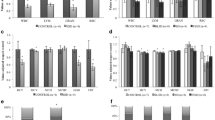Abstract
Ten blue-neck male ostriches (Struthio camelus) were fed Prosopis farcta beans throughout a 30-day experiment. Blood samples were collected from ostriches on days 0 and 30 to measure levels of high-density lipoprotein (HDL) cholesterol, low-density lipoprotein (LDL) cholesterol, triglyceride, total serum protein, albumin, globulin, cholesterol, calcium, inorganic phosphorus, the activity of aspartate aminotransferase, alanine aminotransferase, and γ-glutamyl transferase (γ-GT). From days 0 to 30, HDL cholesterol, total protein, and globulins levels increased significantly whereas LDL cholesterol, inorganic phosphorus, and γ-GT activity decreased significantly.

Similar content being viewed by others
References
Al-Aboudi, A. and Afifi, F. U., 2010. Plants used for the treatment of diabetes in Jordan: A review of scientific evidence. Pharmaceutical Biology, 49(3):221–239
Ali-Shtayeh, M.S. and Jamous, R.M., 2008. Traditional Knowledge of wild edible plants used in Palestine (Northern West Bank): A comparative study. Journal of Ethnobiology and Ethnomedicine, 4: 13
Al-Jeboory, A.A. and W.A.H. Alhusainy., 1984. Cardiovascular studies on Prosopis farcta. Fitoterapia, 55: 137-142
Andrade-Montemayor, H. M., Cordova-Torres, A. V., García-Gasca, T., and Kawas, J. R., 2011. Alternative foods for small ruminants in semiarid zones, the case of mesquite (Prosopis laevigata spp.) and nopal (Opuntia spp.), Small Ruminant Research, 98 (1-3): 83-92
AOAC, 1984. Official methods of analysis (14th edn.). Association of Official Analytical Chemists, Inc., Arlington, Virginia, USA.
Asadollahi, K., Abassi, N., Afshar, N., Alipour, M. and Asadollahi, P., 2010. Investigation of the effects of Prosopis farcta plant extract on rat’s aorta. Journal of Medicinal Plants Research, 4(2):142–147
Bovera, F., Moniello, G., Riu, N., Meo, C., Pinna, W., and Nizza, A., 2007. Effect of diet on the metabolic profile of ostriches (Struthio camelus var. domesticus).Tropical Animal Health and Production, 39(4):265-270
Cardozo, M. L., Ordoñez, R. M., Zampini, I. C., Cuello, A. S., Dibenedetto, G., and Isla, M. I., 2010. Evaluation of antioxidant capacity, genotoxicity and polyphenol content of non conventional foods: Prosopis flour. Food Research International, 43: 1505-1505
Edwards SH, Kimberly MM, Pyatt SD, Stribling SL, Dobbin KD, Myers GL., 2011. Proposed serum cholesterol reference measurement procedure by gas chromatography-isotope dilution mass spectrometry. Clinical Chemistry, 57(4):614-22
Ezike, A., Akah, P., Okoli, C., Udegbunam, S., Okwume, N., Okeke, C., and Iloani, O., 2010. Medicinal plants used in wound care: A study of Prosopis africana (fabaceae) stem bark. Indian Journal of Pharmaceutical Sciences, 72(3):334–339
George, C., Lochner, A., and Huisamen, B., 2011. The efficacy of Prosopis glandulosa as antidiabetic treatment in rat models of diabetes and insulin resistance, Journal of Ethnopharmacology, 137(1): 298-304
Gulalp, B., Karcioglu, O., 2008. The first report of Prosopis farcta ingestion in children: is it serious? International Journal of Clinical Practice, 62(5):829–830
Harzallah-Skhiri, F. and H. Ben Jannet., 2005. Flavonoids diversification in organs of two Prosopis farcta (Banks & Sol.) Eig. (Leguminosea, Mimosoideae) populations occurring in the Northeast and the Southeast of Tunisia, Journal of Applied Sciences Research, 1(2): 130-136
Narasimhacharya, A. V. R. L., Nitesh, K. V and Desai, T. N., 2010. Prosopis juliflora as an antihypercholesterolemic agent, Journal of Herbal Medicine and Toxicology, 4(1):31–34
Norusis MY., 1993. SPSS for widows base system user’s guide release 6.0.1 st edn. SPSS Inc. Michigan, 281-290.
Omidi A, and Ansari nik H., 2012. Selected biochemical values of yearling African blue neck ostriches (Struthio camelus) in Iran. Comparative Clinical Pathology, doi:10.1007/s00580-012-1452-3
Orozco-Villafuerte, J., 2003. Mesquite gum: fractionation and characterization of the gum exuded from Prosopis laevigata obtained from plant tissue culture and from wild trees, Carbohydrate Polymers, 54(3):327–333
Pasiecznik, N. M.; Harris, P. J. C.; Smith, S. J., 2004. Identifying tropical Prosopis species—A field guide. HDRA, Coventry, UK
Penninks, A. H., van Mierlo, G. J. D., Kuper, F., Snel, C. J., Ganderup, N.-C., and Wolterbeek, A. P. M., 2012. Juvenile immunodevelopment in minipigs, 231-254. doi:10.1002/9781118168226.ch12
Quintavalla F., Bigliardi E. & Bertoni P., 2001. Blood biochemical baseline values in the ostrich (Struthio camelus), Annali Facoltà Medicina Veterinaria, 21:61-71.
Rahman, A., Samoylenko, V., Jacob, M., Sahu, R., Jain, S., Khan, S., Tekwani, B., and Muhammad, I., 2011. Antiparasitic and antimicrobial indolizidines from the leaves of prosopis glandulosa var. glandulosa, Planta Medica, 77(14):1639–1643
Robertson, S., Narayanan, N., and Raj Kapoor, B., 2011. Antitumour activity of Prosopis cineraria (l.) druce against ehrlich ascites carcinoma-induced mice, Natural Product Research, 25(8): 857-862
Samour, J., Naldo, J., Libanan, N., Rahman, H., and Sakkir, M., 2010. Age-related hematology and plasma chemistry changes in captive masai ostriches (Struthio camelus massaicus), Comparative Clinical Pathology, 20(6):659-667
Sharma, N., Garg, V., and Paul, A., 2010. Antihyperglycemic, antihyperlipidemic and antioxidative potential of Prosopis cineraria bark, Indian Journal of Clinical Biochemistry, 25(2):193–200
Singh, B., Bhat, T. K. and Singh, B., 2003. Potential therapeutic applications of some antinutritional plant secondary metabolites, Journal of Agricultural and Food Chemistry, 51: 5579-5597
Van Soest, P.J., Robertson, J.B. & Lewis, B.A., 1991. Methods for dietary fiber, neutral detergent fiber, and nonstarch polysaccharides in relation to animal nutrition, Journal of Dairy Science, 74, 3583-3589
Vernon-Carter, E. J., Beristain, C. I., and Pedroza-Islas, R,. 2000. Mesquite gum (Prosopis gum). In Doxastakis, G. and Kiosseoglou, V., editors, Novel Macromolecules in Food Systems, volume 41 of Developments in Food Science, pages 217–238. Elsevier.
Wang, R. E., Tian, L., and Chang, Y.-H., 2012. A homogeneous fluorescent sensor for human serum albumin, Journal of Pharmaceutical and Biomedical Analysis, 63:165-169
Zhu, K., Zhang, Y., He, S., Chen, W., Shen, J., Wang, Z. and Jiang, X., 2012. Quantification of proteins by functionalized gold nanoparticles using click chemistry, Analytical Chemistry, doi:10.1021/ac3010567
Acknowledgement
The authors gratefully acknowledge the financial support for this work that was provided by the Vice Chancellor for Research at Birjand University and the kind help of animal research center of Zabol district, especially Dr. Jahantigh for completing this study. The manuscript was edited by Manuscript Editor Online.
Author information
Authors and Affiliations
Corresponding author
Rights and permissions
About this article
Cite this article
Omidi, A., Ansari nik, H. & Ghazaghi, M. Prosopis farcta beans increase HDL cholesterol and decrease LDL cholesterol in ostriches (Struthio camelus). Trop Anim Health Prod 45, 431–434 (2013). https://doi.org/10.1007/s11250-012-0234-x
Accepted:
Published:
Issue Date:
DOI: https://doi.org/10.1007/s11250-012-0234-x




